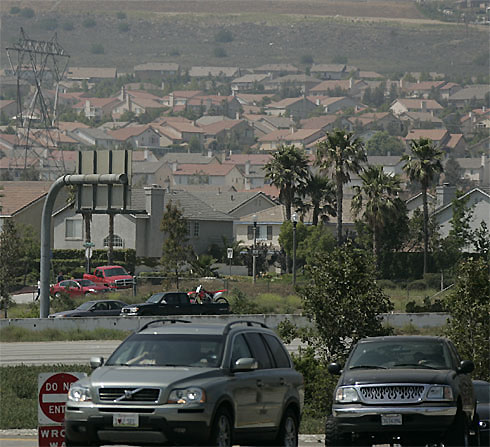by John Ritter on 21 June 2007 in USA Today
San Bernardino, California - This vast county east of Los Angeles, the biggest in the continental USA, could hold the states of Connecticut, Delaware, Vermont and Rhode Island and still have room left over. Most of San Bernardino County remains mountains and empty desert.
But an ever-larger piece, the part known as the "Inland Empire," is freeways, fast-growing cities, traffic congestion and seemingly endless sprawl. For years, this has been the refuge, with Riverside County to the south, for hundreds of thousands of home buyers fleeing soaring Los Angeles prices.
STATES TAKE NOTE: California blames sprawl for global warming.
The county's 2 million population will grow by at least 500,000 by 2030, according to state estimates. The conventional way growth has always been handled here is to build more single-family subdivisions — the suburban dream, for sale on a third of an acre.
"San Bernardino has never seen a project it didn't like," says Brendan Cummings, a senior attorney with the Center for Biological Diversity, an environmental group that has brought several lawsuits in the Inland Empire over global warming. "They rubber-stamp development. It's very much of a frontier mentality."
Test case draws attention
Opponents of sprawl have found an unexpected ally: global warming. They see unfettered sprawl as a big contributor to greenhouse gases that fuel warming, mainly from the fossil-fuel burning homes, businesses and traffic it creates.
The state and conservation groups have made San Bernardino County a test case of that status quo. California Attorney General Jerry Brown sued the county in April under the state's environmental quality act for failing to account for the impacts of global warming in the county's 25-year growth plan, approved in March.
The Center for Biological Diversity, the Sierra Club and the San Bernardino Valley Audubon Society sued in a separate case.
"Although this is a global problem, we think every local agency and city and county has to take some steps to solve it," says Susan Durbin, the deputy attorney general handling the state's case.
California last year passed the nation's first law ordering an across-the-board 20% reduction of greenhouse gases by 2020. The attorney general is looking for more ways other laws can support the new mandate, Durbin says.
County officials protested that Brown injected global warming demands into a planning process years in the making and that the state had given localities no rules on how to abide by the new law.
Even so, the county redid its plan to combat global warming, yet Brown still sued, says county spokesman David Wert. He says the county will make sure employment centers and housing are near transportation corridors to reduce traffic and do more to promote compact development and mass transit.
Wert points out that only 15% of the county is controlled by the county; the rest is cities and federal and state land. The county has budgeted $325,000 to fight the lawsuit.
The plaintiffs want the county to rewrite its growth plan's environmental impact section to include methods to measure greenhouse gases and take steps to reduce them.
Durbin and environmentalists say the county addressed global warming with few specifics. The county could have required developers to build energy-efficient homes, they say. It could have ordered denser subdivisions and more multifamily construction, paid for mass-transit projects instead of pushing driving alternatives and mandated tree-planting to capture carbon dioxide, a greenhouse gas.
National forests in San Bernardino County have had one of the USA's highest wildfire rates in recent years, a condition likely to worsen if global warming brings extended droughts and dry timberlands. Yet the county has done little to restrict resort and second-home development in mountain regions or to expand already inadequate escape routes from fires, says Steven Farrell, the Sierra Club's local chapter's vice chairman.
Marin County's example
The flip side of that is Marin County. The Northern California enclave took a forceful approach to greenhouse gases in a growth plan likely to be approved this year. The county set up standards to measure greenhouse gases and set targets for reducing them.
Surrounded on three sides by water, Marin also started planning for possible rising sea levels, as polar ice melts, by identifying areas that shouldn't be developed or, if already built might need sea walls and levees. Marin has long had a progressive, "green" electorate, so fighting global warming came naturally, says community development director Alex Hinds. "We feel fortunate that our population recognizes these concerns," he says.
Environmental groups are also focusing on specific developments in San Bernardino and Riverside counties that they claim ignore greenhouse-gas impacts. A suit filed in November by the Center for Biological Diversity against Banning, Calif., says the city failed to analyze greenhouse-gas emissions when it approved 1,500 new homes on 1-acre lots on open space it planned to annex.
"It's coincidental that our first wave of litigation has all been down here," says Kassie Siegel, the center's climate program director. "But to some degree it's not, because we have the nation's worst sprawl."
The lawsuits are a wake-up call, says Cary Lowe, a San Diego lawyer and planning consultant. "Cities and counties are scrambling, absolutely," he says. "They know there's a good chance they'll get sued."
see also:
Island Breath: Get Used to Life on Mars 5/11/2007
Island Breath: No More Mr. Nice Guy 2/11/2006
Island Breath: 20 Years to Fix Climate Change 1/20/2006
Island Breath: Clinton on Global Warming 12/15/2004
Island Breath: God Must Hate Florida 10/6/2004
Island Breath: Gore on Global Warming 1/16/2004 |
